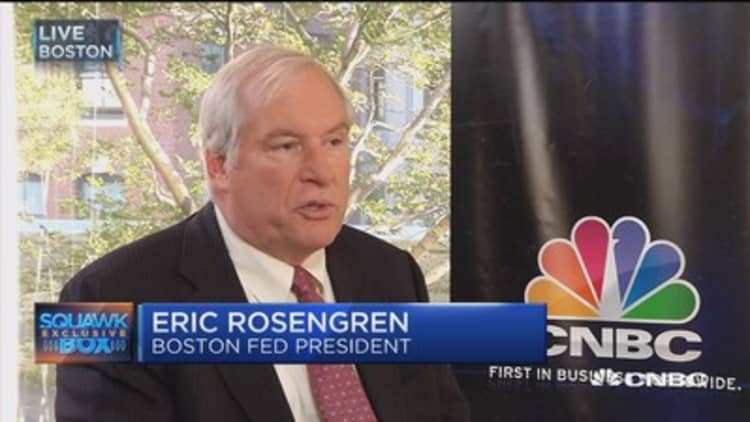
Boston Federal Reserve President Eric Rosengren told CNBC on Friday the economy was close to hitting full employment and close to the Fed's 2 percent inflation target, so interest rates should rise "slowly and gradually."
"We tended to move around the time that the chair has a press conference. So the next press conference meeting is in December. There's a much higher probability in December," he said on "Squawk Box."
The futures market implies odds of about 65 percent for a hike at the central bank's December meeting.
"To me, that seems quite appropriate," said Rosengren, a voting member this year on the central bank's policymaking panel and one of three dissenters at the September meeting, when the Fed held rates steady.
"GDP growth looks like it's going to be strong enough in the second half of the year to ... [keep] the unemployment rate drifting down," he said, adding he's not worried about inflationary dangers from rising wages and prices.
A December move would be one year after policymakers raised rates for the first time in more than nine years.
A dove who turned hawkish, Rosengren said his views have not changed — the economic conditions have. "We have to do what makes sense for the U.S. economy."
When the unemployment rate was 10 percent in 2009 in the fallout from the financial crisis, "very aggressive" stimulus was needed, he said.
But with the current jobless rate half that — at 5 percent in the government's September jobs report — "those conditions are very different," he added, saying he's concerned about "overshooting on what is a sustainable unemployment rate."
Rosengren sees the jobless rate at 4.5 percent by the end of 2017. The unemployment rate was 5 percent in the government's September jobs report.
"There are clearly benefits to a low unemployment rate," he said, but added that waiting longer to hike rates may mean a faster pace of increases down the road and "possibly shortening the recovery."
The Fed also meets next month, concluding its two-day meeting six days before Election Day. The market only sees about an 8 percent chance of a November move. But Rosengren did say each of the Fed's meeting should be considered "live."
Rosengren said he's concerned about a number of "anomalies in the recovery," including the rise in commercial real estate prices, as investors pile in looking for yield because rates are so low.


